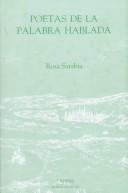| Listing 1 - 4 of 4 |
Sort by
|

ISBN: 1855660393 9781855660397 Year: 1997 Volume: 162 Publisher: London : Tamesis,
Abstract | Keywords | Export | Availability | Bookmark
 Loading...
Loading...Choose an application
- Reference Manager
- EndNote
- RefWorks (Direct export to RefWorks)
This study analyses the use of colloquial language in the works of a number of modern Latin-American poets, Raúl González Tuñón, Nicanor Parra, Ernesto Cardenal, Rosario Castellanos, and Luisa Futoransky. The function of colloql speech is examined as an integral part of the structural dynamics of the poetic texts selected for study. The works under discussion are viewed in the context of other strands of literary criticism and theory, including reception theory, poststructuralism, feminism, cultural poetics, and ideology.
Spanish American poetry --- Spanish language --- History and criticism. --- Spoken Spanish --- González Tuñón, Raúl, --- Parra, Nicanor, --- Castellanos, Rosario --- Futoransky, Luisa, --- Cardenal, Ernesto --- Language. --- Spanish American poetry - 20th century - History and criticism. --- Spanish language - Spoken Spanish - Latin America. --- González Tuñón, Raúl, - 1905-1974 - Language. --- Parra, Nicanor, - 1914- - Language. --- Castellanos, Rosario - Language. --- Futoransky, Luisa, - 1939- - Language. --- Cardenal, Ernesto - Language. --- POESIE HISPANO-AMERICAINE --- 20E SIECLE --- González Tuñón, Raúl, - 1905-1974 --- Parra, Nicanor, - 1914 --- -Castellanos, Rosario --- Futoransky, Luisa, - 1939 --- -Cardenal, Ernesto
Book
ISBN: 3964561630 8484893111 Year: 2007 Publisher: Madrid ; Frankfurt am Main : Iberoamericana : Vervuert,
Abstract | Keywords | Export | Availability | Bookmark
 Loading...
Loading...Choose an application
- Reference Manager
- EndNote
- RefWorks (Direct export to RefWorks)
Estudio de la poesía visual del poeta chileno centrado en "Japonerías de estío" (Canciones en la noche, 1913), "Tour Eiffel" (1918) y en los poemas pintados por el mismo Huidobro para la exposición "Salle 14" (París 1922).
Hispanic Literature, general. --- Literary Studies. --- LITERARY CRITICISM / American / General. --- Huidobro, Vicente, --- Crítica e interpretación. --- Criticism and interpretation. --- Fernández, Vicente García Huidobro, --- García Huidobro Fernández, Vicente, --- Huidobro Fernández, Vicente, --- Huidobro, V. --- Huidobro, Vincent,
Book
ISBN: 9788484893110 9783865273406 Year: 2007 Publisher: Madrid : Frankfurt : Iberoamericana Vervuert,
Abstract | Keywords | Export | Availability | Bookmark
 Loading...
Loading...Choose an application
- Reference Manager
- EndNote
- RefWorks (Direct export to RefWorks)
Book

ISBN: 3110527030 3110527839 9783110527834 9783110527032 9783110527841 3110527847 9783110526882 Year: 2017 Publisher: Berlin Boston
Abstract | Keywords | Export | Availability | Bookmark
 Loading...
Loading...Choose an application
- Reference Manager
- EndNote
- RefWorks (Direct export to RefWorks)
Futurism Studies in its canonical form has followed in the steps of Marinetti's concept of Futurisme mondial, according to which Futurism had its centre in Italy and a large number of satellites around Europe and the rest of the globe. Consequently, authors of textbook histories of Futurism focus their attention on Italy, add a chapter or two on Russia and dedicate next to no attention to developments in other parts of the world. Futurism Studies tends to sees in Marinetti's movement the font and mother of all subsequent avant-gardes and deprecates the non-European variants as mere 'derivatives'. Vol. 7 of the International Yearbook of Futurism Studies will focus on one of these regions outside Europe and demonstrate that the heuristic model of centre - periphery is faulty and misleading, as it ignores the originality and inventiveness of art and literature in Latin America. Futurist tendencies in both Spanish and Portuguese-speaking countries may have been, in part, 'influenced' by Italian Futurism, but they certainly did no 'derive' from it. The shift towards modernity took place in Latin America more or less in parallel to the economic progress made in the underdeveloped countries of Europe. Italy and Russia have often been described as having originated Futurism because of their backwardness compared to the industrial powerhouses England, Germany and France. According to this narrative, Spain and Portugal occupied a position of semi-periphery. They had channelled dominant cultural discourses from the centre nations into the colonies. However, with the rise of modernity and the emergence of independence movements, cultural discourses in the colonies undertook a major shift. The revolt of the European avant-garde against academic art found much sympathy amongst Latin American artists, as they were engaged in a similar battle against the canonical discourses of colonial rule. One can therefore detect many parallels between the European and Latin American avant-garde movements. This includes the varieties of Futurism, to which Yearbook 2017 will be dedicated. In Europe, the avant-garde had a complex relationship to tradition, especially its 'primitivist' varieties. In Latin America, the avant-garde also sought to uncover and incorporate alternative, i.e. indigenous traditions. The result was a hybrid form of art and literature that showed many parallels to the European avant-garde, but also had other sources of inspiration. Given the large variety of indigenous cultures on the American continent, it was only natural that many heterogeneous mixtures of Futurism emerged there. Yearbook 2017 explores this plurality of Futurisms and the cultural traditions that influenced them. Contributions focus on the intertextual character of Latin American Futurisms, interpret works of literature and fine arts within their local setting, consider modes of production and consumption within each culture as well as the forms of interaction with other Latin American and European centres. 14 essays locate Futurism within the complex network of cultural exchange, unravel the Futurist contribution to the complex interrelations between local and the global cultures in Latin America and reveal the dynamic dialogue as well as the multiple forms of cross-fertilization that existed amongst them.
Yearbooks. --- Annuals --- Year-books --- Serial publications --- Almanacs
| Listing 1 - 4 of 4 |
Sort by
|

 Search
Search Feedback
Feedback About UniCat
About UniCat  Help
Help News
News